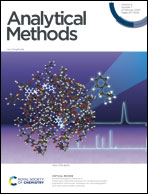Automated sample preparation and GC-API-MS/MS as a powerful tool for analysis of legacy POPs in human serum and plasma†
Abstract
An automated high-throughput solid phase extraction method for selected persistent organic pollutants (POPs) comprising 17 organochlorine pesticides, 22 polychlorinated biphenyls (PCBs), 9 polybrominated diphenylethers (PBDEs) and octachlorostyrene (OCS) in human serum and plasma was developed. Importance was attached to application of small volumes of reagents and solvents in addition to low sample volumes (150 μL) in order to save the highly valuable sample material for follow-up and other studies. Instrumental analysis was performed by gas chromatography with atmospheric pressure ionisation coupled to tandem mass spectrometry (GC-API-MS/MS). The recoveries of the selected analytes were satisfactory and between 70% and 120% for most of the compounds at three investigated spike concentrations (75 pg mL−1, 450 pg mL−1 and 1250 pg mL−1). Inter-day recoveries were within 80–120% for pesticides and within 86–130% for PCBs and PBDEs with RSDs ranging from 2% to 35%. The accuracy of the method was evaluated with standard reference materials and samples from the ringtest of the Arctic Monitoring and Assessment Programme and was slightly better with lower RSDs for most of the compounds compared to that of previously published methods. Method detection limits (MDLs) ranged from 0.009 pg mL−1 to 34.6 pg mL−1 for pesticides, from 0.435 pg mL−1 to 57.8 pg mL−1 for PCBs and from 0.855 pg mL−1 to 34.6 pg mL−1 for PBDEs when blank contamination was taken into account. Low MDLs together with high accuracy, repeatability and robustness were demonstrated for an appropriate concentration range. The applicability for real samples was satisfactorily demonstrated by analysis of 40 serum samples from the general population of Tromsø, Norway, where in total 33 analytes were measured above the MDLs. The most important marker compounds are detected in this low exposure population which shows the suitability of the presented method for retrospective as well as prospective studies with high number of samples.



 Please wait while we load your content...
Please wait while we load your content...